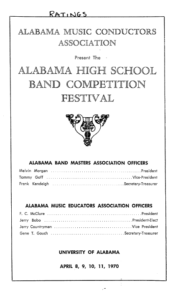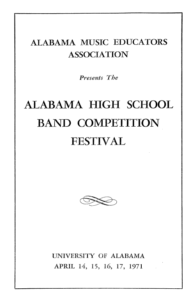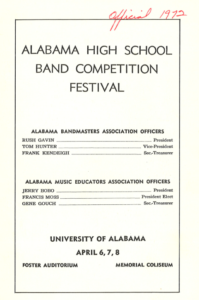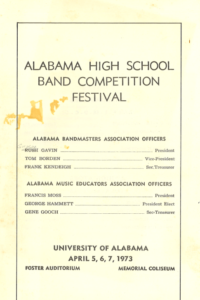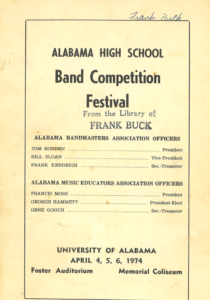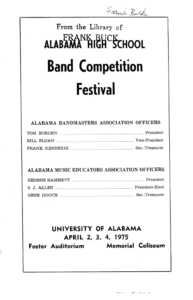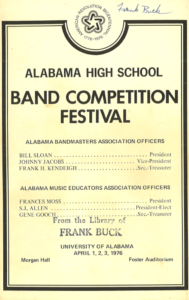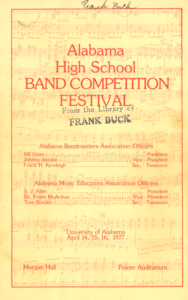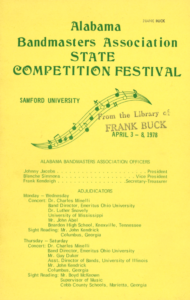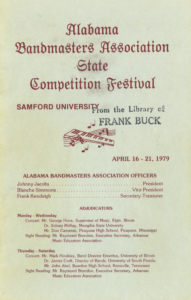1940‘s – 1950‘s – 1960‘s – 1970‘s – 1980‘s – 1990‘s – 2000‘s – 2010‘s – 2020‘s
The 1970s saw continued growth in the size of schools and their band programs and an expansion of the Solo & Ensemble Festival. It is a decade that would end with “State Contest” moving from its traditional Tuscaloosa home. Enjoy reading about this part of the history of Alabama’s school band movement and the members of the Phi Beta Mu Hall of Fame who helped shape it.
Click the year or the program cover to open a PDF of the printed program.
1970
This year, we see another classification, “Class CC” added, enrollment adjustments for high schools, and an interesting trend with the classification of junior high bands.
The classifications are now as follows:
- Class AA 1,500 or more students
- Class A 1,000-1,499
- Class BB 750-999
- Class B 500-749
- Class CC 300-499
- Class C Less than 300
With “Class E,” we see a grade level distinction. Whereas a three-year junior high school would be “Class EE” versus “Class E” depending on the size of the school, now a junior high without a 9th grade is classified as “Class E” regardless of its size. Over the coming years, we will see the trend to classify high school bands by enrollment but classify young bands according to the years of playing experience.
For the first time since the early 1950s, the competition-festival was held some place other than Foster Auditorium. The junior high bands performed at Tuscaloosa High School. Simultaneously, “Class C” bands performed at Memorial Coliseum.
At each site, the first band received a “Superior.” However, Eastwood Jr. High would be the only band in the competition-festival to receive that rating and the only junior high in the state to receive that rating. At Memorial Coliseum, Gordo began the day with a “Superior.” That panel would not award another “Superior” until the late afternoon. Grissom, making its first appearance at the competition-festival, and Anniston played back-to-back, each receiving a rating of “Superior.”
The second day yielded only two “Superior” ratings. They went to Fayette County High School (Jerry Bobo) and Fairhope High School (Blanche Simmons). Both directors are Hall of Fame members. On the third day of the event, only two bands received “Superior” ratings: Elmore County High School (Truman Welch) and Auburn High School (Tommy Goff). Both directors are Hall of Fame members.
On the final day, bands in Class A and Class AA performed. Seven bands received “Superior” ratings. Four of those went to Hall of Fame members: Austin High School (Bill Brunner), Decatur High School (Jerry Countryman), S. R. Butler High School (Frank Kendeigh), and Huntsville High School (Bill Sloan). On the final day of the event, five of the final nine bands (all “Class AA”) received “Superior” ratings.
This year, the way final ratings were calculated changed, although this change is not discussed in the printed program, but is discussed the following year. To this point, the final rating was determined by the three prepared-music scores. To receive a “Superior,” a band had to receive a “Superior” from at least two of the three judges. Sight-reading could only lower a band’s score. A high school band could receive an overall rating only one division higher than the sight-reading score.
Starting this year, a “point system” was instituted. The three prepared-music scores and the sight-reading score were now seen as equal. Five points were awarded for each “Superior,” four points for each “Excellent,” three points for each “Good,” and two points for each “Fair” rating. Final ratings were computed by adding the points:
- Superior: 18-20
- Excellent: 14-17
- Good: 10-13
- Fair: 8-9
A band receiving a I-II-II and earned a “I” in sight-reading received an overall “Superior.” The caveat remained, however, that bands in Class C through AA could not receive an overall rating more than one division higher than the sight-reading score.
As one examines the scores for the junior high bands, this new scoring system must not have been applied. Of the 12 junior high bands that performed, only one received an overall “Superior” rating. If the “point” system had been applied, seven of the remaining 11 would have been rated a division higher.
Out of a total of 82 bands, 15 received a “Superior” rating (18%). An “Excellent” rating was awarded to 36 bands (44%). A rating of “Good” was awarded to 28 bands (34%), and a “Fair” was given to 3 bands (4%).
1971
Hall of Fame member John Bradley made his debut this year with his Westside (Selma) Jr. High School band. Hall of Fame member Tommy Brannan also made his debut with his Riverside Jr. High School band. This band was actually a combination of the bands from Riverside and Northport Junior High, both bands located in Northport. William T. Robinson, III made his debut with his Ed White Junior High School band.
This year’s printed program includes an explanation of the rating system implemented the year before. The explanation includes the statement, “Class EE, E, and D bands will sight-read for criticism only and it will not affect their scores.” The sentiment would seem younger bands are being spared having their ratings hurt by a poor sight-reading score. As one examines scores, rarely would this situation have been the case. In most cases, including the sight-reading score would improve the rating. A high school band with a I-II-II and a I in sight-reading would receive a “Superior” while a junior high with the exact same scores would receive an “Excellent.” We see this situation addressed several years later.
The Alabama High School Band Competition Festival grew this year to 97 bands. Several high schools brought “second bands,” a trend that would continue and grow over the years.
1972
The Alabama High School Band Competition Festival had traditionally been held over four days with all bands playing at Foster Auditorium. For the last two years, junior high bands played at Tuscaloosa High School during the first day while Class C bands were performing at Memorial Coliseum.
To accommodate the number of participating bands, the event was reconfigured this year to run three days at two sites for all three of those days. Bands up through Class CC performed at Foster Auditorium while Class B through Class AA performed at Memorial Coliseum.
The classification system expanded to include “Class F.” Schools were shifting from the typical 7th-9th grade junior high school to a 6th-8th grade middle school model. “Class F” indicated the school had no 9th grade. No distinction was made as to the size of the school.
1973
The number of bands in the Alabama High School Band Competition Festival continues to grow. Participation among junior high and middle school bands. Within two years, these bands grew from one day to almost two full days. A total of 103 bands participated in this year’s competition-festival.
Hall of Fame member Gene Gooch made his debut with his Coffee High School Band.
1974
The way ratings for middle school and junior high school bands changed this year to include sight-reading. Now, a young band which scored a I-II-II on stage and a “I” in sight-reading would receive an overall “Superior” just as their high school counterparts had been receiving for several years. The only difference was the stipulation for high school bands that they could not receive an overall rating mor than one division higher than their sight-reading score.
Hall of Fame member Jim Duren made his debut with his Mountain Brook Jr. High School band. Hall of Fame member Mike Stough makes his debut as he and Milton Welch bring their Elmore County High School band.
1975
This year’s competition-festival remained at two sites. Troy served as one hosting. The University of North Alabama served as the other. Of the 97 bands, 29 received a “Superior” rating (30%). An “Excellent” rating was awarded to 44 bands (45%). A rating of “Good” was awarded to 23 bands (24%), and one band received a rating of “Fair.” The “Superior” ratings were skewed in favor of larger schools with the final eight bands (one Class A and seven Class AA) all receiving a “Superior” rating.
Hall of Fame member Harry McAfee made his debut with the Bottenfield Junior High School band.
1976
Hall of Fame member Ken Williams made his debut at the Alabama High School Band Competition Festival with the Meek High School band. A total of 109 bands participated in this year’s event. Hall of Fame member Johnny Folsom made his debut with his Geneva High School Band.
1977
A significant change happened this year, one that was arguably the first step toward our current Music Performance Assessment held at the district level. Before this year, bands received a “Yes” or “No” rating from the three-judge panel at the district competition-festivals held around the state. A “Yes” was awarded if the adjudicator felt with normal continued improvement the band would receive a “Superior” or “Excellent” at the state level.
Beginning this year, bands received ratings of I, II, III, or IV from each judge at the district level. To be recommended for the state competition-festival, a band needed a “I” from at least two adjudicators. In essence, a “I” was equivalent to a “Yes.” A II, III, or IV was equivalent to a “No.” The feeling was developing bands could see progress year-to-year if they moved from making a “III” to making a “II,” for example.
This year’s festival hosted 109 bands, exactly the same number as the previous year.
One interesting fact is during the course of this year’s state competition-festival, the panel judging the Class F-CC bands awarded only one unanimous “Superior” rating: Gordo High School under the direction of Phi Beta Mu member Jim Knight.
1978
Hall of Fame member Garry Taylor makes his debut at the Alabama High School Band Competition Festival with his Brooks High School band.
After decades at the University of Alabama, the location of this year’s event moved to Samford University. Rather than having two panels of judges running simultaneously at two locations over three days, this year’s event ran for six days with all bands performing in one location.
The name of the event changed slightly this year. The printed program from years past read, “Alabama High School Band Competition Festival.” This year’s program reads, “Alabama Bandmasters Association State Competition Festival.” The title is more accurate given the large number of middle school and junior high bands participating.
1979
Samford proved to be a good central location. Participation held steady with 105 bands performing.
